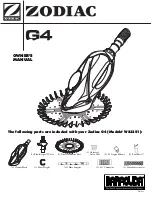
N e p t u n e
™
1 . 2 5 H P P o o l P u m p M o t o r
I n s t a l l a t i o n a n d O p e r a t i o n M a n u a l
25
Troubleshooting
This troubleshooting guide provides field technicians a step-by-step process for accurately diagnosing
and troubleshooting certain problems experienced by the Neptune
™
1.25HP pool motor.
This section however does not override or replace instructions suggested by the manufacturer of the
pump system. To prevent misdiagnosis and unneeded repairs, operators should try the steps listed in
the Basic Troubleshooting section first. If a problem still exists or there is an ongoing issue after following
the steps in the Basic Troubleshooting section, then move to the General Troubleshooting section for
further guidance.
Installation, operation, and maintenance must be performed by qualified personnel. Familiarization with
and adherence to the National Electrical Code (NEC), National Fire Protection Association (NFPA)
standards, and to local codes are required. It is important to observe safety precautions to protect
personnel from possible injury.
·
Code requirements differ from state to state. Install equipment using qualified electricians in
accordance with the applicable codes and ordinances in your area and in accordance with the NEC.
All electrical connections should be made and maintained by a qualified or licensed electrician.
·
Always disconnect electrical power at the fuse box or circuit breaker panel before handling electrical
connections or performing maintenance on this unit. Allow the motor to come to a complete stop
and wait two (2) minutes. This allows the capacitors to discharge any residual voltage.
·
Wear safety glasses to inspect the equipment while it is running or while working on equipment.
Basic Troubleshooting
Motor shaft is not spinning or runs abnormally
·
Verify that the pump should be running, based on the time of day and how you have the sequence
of Timers programmed in the pump.
·
Check the circuit breaker for trips or accidental shutoff.
·
Verify that the signal cable and electrical power leads are securely connected to the control
connectors. Inspect for shorts, detached wiring, or loose connections.
Motor rattles or makes excessive noise
·
Inspect the motor for accumulated dirt and debris, or other signs of damage.
·
Inspect the motor for secure mounting to the system chassis.
·
Inspect the screws on the Wiring Compartment Cover and the High Voltage Compartment Cover.
Verify that they are securely tightened.
·
Inspect the shaft; verify that the shaft is not bent and that the motor shaft spins freely in both
directions.









































